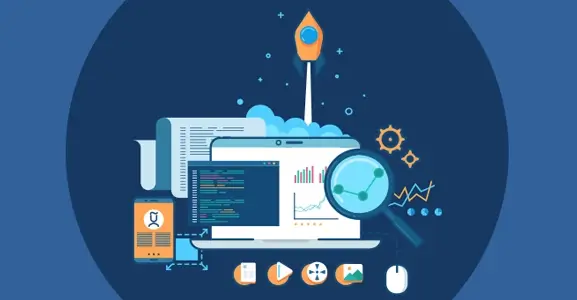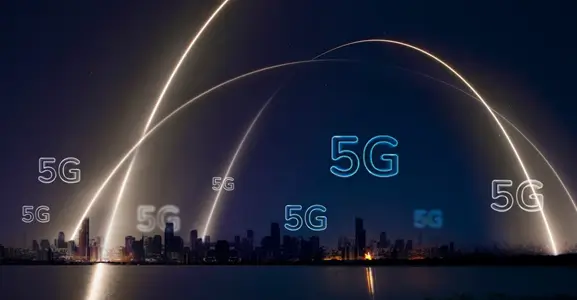5G is the 5th generation cellular network. It is the latest version of global wireless networks after networks like 1G, 2G, 3G, and 4G. 5G has the upgraded potential to connect the world virtually, be that humans, machines, objects, and devices. 5G has been designed to expand the mobile ecosystem enabling new horizons.
It impacts every industry, such as transportation, healthcare, agriculture, and logistics, along with its high speed and superior reliability.
In simple terms, Fifth-generation wireless called 5G is the latest iteration of cellular technology, designed to increase the speed and responsiveness of wireless networks efficiently. It directly impacts internet-dependent businesses. Go through the content to know more about the benefits, importance, future, and current scenario of 5G in India concerning business enterprises that rely heavily on the Internet.
What Is 5G Technology?
5G is fundamentally all about the next level of wireless communication. 5G has been referred to as the dynamic component of the latest economy as it ensures the rise of a speedier and more networked future in technology.
A new era began with the rise of 3G and 4G LTE, which introduced us to smartphones. It was a boon in the industry as it gave us access to streaming music and movies. 5G will have higher wavelength base stations, also known as antennas, spread throughout highly dense cities to serve devices within range of each antenna.
5G has enormous potential, which takes technology to the next level. Though it works on the same radio frequency used by the latest smartphones and Wi-Fi networks, it enables technology to go a long run. 5G is all about connecting things around the globe – extremely reliably, with no lags, giving people an edge to measure, understand and manage things in real-time.
5G Network In India
India witnessed the 5G network services inaugurated in the country on October 1, 2022. The Prime Minister officially introduced 5G in some cities, promising its reach in the nation within a short period. With 5G in India, the country can experience faster connectivity speeds, greater bandwidth, and ultra-low latency, transforming industries and vividly enhancing day-to-day experiences.
However, 5G is confined to limited regions across the country. Only Airtel and Jio have started the beta trials in just Tier–1 regions, and covering up Pan-India will take a lot more time, and it could take up to one year to complete the process. So, unless you live in a Tier-I region, 5G networks may not be accessible anywhere between a few months to a complete year or more.
Read More: How To Get The Most Out Of Voice Calling API Service To Empower Your Business ?
Advantages Of 5G Over 4G In India
5G Offers Several Advantages Over 4G In India:
- Blazing Fast Speeds: 5G provides significantly faster internet speeds compared to 4G, enabling quicker downloads, smoother streaming, and reduced latency. 5G can reach the speed of 10 GBPS (Giga Bytes Per Second), which is 100 times faster than the existing 4G network. It shows that the work can be done 100 times faster. It will be a boon for AR/VR industries and cloud gaming portals which will enhance over time.
- Low Latency: With reduced latency, 5G ensures almost real-time data transfer, which is crucial for applications like online gaming, video conferencing, and IoT devices.
- Enhanced Capacity: 5G networks can support a larger number of connected devices simultaneously, making it ideal for crowded urban areas and smart city initiatives.
- Improved Connectivity: 5G offers seamless connectivity even in remote or underserved regions, potentially bridging the digital divide in India.
- IoT and Industry 4.0: 5G facilitates the growth of the Internet of Things (IoT) and Industry 4.0 by providing the necessary connectivity for smart homes, smart factories, and automation.
- Innovative Applications: It enables emerging technologies like augmented reality (AR), virtual reality (VR), and autonomous vehicles, opening up new possibilities for entertainment and transportation.
- Economic Growth: The deployment of 5G can stimulate economic growth by fostering innovation, supporting startups, and creating jobs in the technology sector.
- Healthcare and Education: 5G can enhance telemedicine and online education by offering high-quality, real-time interactions, particularly beneficial in India’s diverse and remote regions.
- Energy Efficiency: 5G networks are designed to be more energy-efficient than previous generations, contributing to a greener and sustainable future.
- Security: Although it brings new security challenges, 5G networks can be designed with robust security measures to protect user data and critical infrastructure.
- Minimal Costing: The cost reduction has further ensured the success of the 5G network in India. In the last ten years, the cost of 1 GB of data was around INR 300, whereas now it has been reduced to INR 10 per GB.
Read More: What Is Conversational AI And How Does It Work ?
What Is The Future Of 5G Technology?
5G stimulates an immense digital transformation, from agriculture to transportation, from entertainment to product development. 5G connects spaces and systems in many countries, benefitting the citizens in many ways. It provides faster connectivity, a more competent traffic system, low latency, and better reliability among businesses and industries.
Keeping a futuristic approach, 5G can benefit its customers through its transformative powers underlying five essential areas –
-
Enhanced Mobile Broadband (EMBB)
5G delivers high bandwidth up to 10 gigabytes per second. It enables ultra-high-definition(UHD) video and data volumes. High-speed mobile broadband supports applications that need rich data transfer in both the directions (upstream and downstream), such as virtual reality and extended reality (XR).
-
Massive Internet Of Things (MIoT)
5G can provide synchronized connectivity of up to one million connections per square kilometer. The key to implementing advanced huge IoT applications is its high connectivity.
-
Mission-Critical Services (MCS)
Remote intensive care units, which come under Mission-critical applications, require reliability and speed. 5G can carry network traffic with very low latencies, making it fit for futuristic development.
-
Private Wireless
With the advancement of 5G technology, an era of private wireless networks has been initiated. Private wireless offers a network solution that locks business-critical operations. Private 5G networks can support indoor and outdoor operations, iresspective of the impact of ad hoc amd legacy wireless designs.
-
Network Slicing
A network slice is a configuration allowing multiple networks to be formed on top of a standard physical infrastructure. It is a valuable solution for wide-area networks. It will enable a connectivity provider to create fit-for-purpose connectivity solutions in which the customer gets a “share” of the public network tailored to their goals.
Conclusion
As we have noticed above that the broad spectrum of 5G offers compelling reasons for future growth. A digital revolution such as automation, Internet of Things, and Artificial Intelligence (AI) will provide a good opportunity for the services industry. Once India reaches its target of 100 smart cities enabled with intelligent power and urban utility systems, there will be no turning back. A timely roll-out of 5G will allow Indian entrepreneurs to experiment with their global competitors.
Some futuristic services, such as connected vehicles, eHealth, traffic systems, and advanced mobile cloud gaming, have arrived with the onset of 5G networking. With 5G technology, we are sure to create a smarter, safer, and more sustainable future. This blog puts weight on the growing impact, benefits, and future of 5 G technology in India. Moreover, how 5G is about to impact internet-dependent business enterprises.
Suppose you need real-time customer engagement marketing solutions through the best use of 5G technology for winning customers. In that case, timely advice from a reliable cloud communication services provider can make a big difference in India. For more information on cloud-based communication services and solutions, call 1800 137 3839. You can also send an email to Fonada executives at info@fonada.com.
FAQs
The launch of 5G in India took place on October 1, 2022. Prime Minister Narendra Modi officially introduced 5G in some cities, promising its reach in the entire nation within a short period. Currently, only two networks Airtel and Reliance Jio have started their trial in the Indian market.
The key difference that matters the most between 4G and 5G is its speed.5G is much faster and more reliable than 4G. Moreover, it offers lower latency and better bandwidth.
If you are using Android phone, open ‘Settings.’ Go to ‘Network and Internet. Select ‘Sim’ and choose the ”Preferred Network Type’ option, then select ‘5G network’.
5G is designed to deliver up to 20 Gbps data speed with lesser latency. It supports huge network capacity and is efficiently reliable with a more consistent user experience.
5G Wireless Technology systems work on two main components, i.e., the Core Network and the Radio Access Network. It provides high networking capacity and low latency, making it unique and more advanced.
5G delivers up to 20 Gigabits-per-second (Gbps) data rates and 100+ Megabits-per-second (Mbps) average data rates. 5G is 100x more capable than 4G in traffic capacity and network proficiency.
5G technology has a wide-ranging potential to pave the way for reconnaissance drones. It is a revolution in strengthening communication infrastructure and can also enable advanced healthcare systems, transportation, public safety, and many more.
Open the Settings app on your mobile, then select ‘Mobile Network.’ After that, select the ‘Preferred Network Type’ option. Finally, tap on the 5G network to activate it.

Dec 11, 2024
Top Contact Center Optimization Tools For 2024
“A thriving business knows how to fetch maximum output from limited resources by optimizing ca... Read More
Nov 13, 2024
What Is Brand Communication? CPaaS Role Explained
Did you ever wonder why some advertisements grab your attention instantly, while others do not? The... Read More
Nov 01, 2024
What Is Automated Messaging And How Does It Work?
Automated messaging or text automation empowers businesses and marketing professionals to connect wi... Read MoreLatest Updates
From Fonada
Industry Insights, Trends, Innovations, Updates, and Case Studies from Industry Experts
View
Customer
Reviews
Discover why our customers love us - read their authentic and heartfelt reviews!
View
Case
Studies
Explore real-life scenarios, offering analysis, and solutions to practical challenges
View
Convert Leads Into Sales With Fonada
Trusted CPaaS Solution Provider








